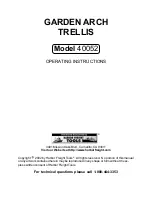
Click back to Table of Contents
Handbook_TileLink Version 03.16
Page 3 of 12
WARNINGS
READ CAREFUL
LY SOMEONE’S LIFE DEPENDS ON IT
The building or structure for the anchorages should be assessed by an engineer, unless it is
clear to a competent person that the anchorages system is structurally adequate.
INSTALLATION MUST BE CARRIED OUT BY, OR UNDER THE SUPERVISION
OF A COMPETENT PERSON.
STANDARD EYEBOLTS MUST ONLY BE USED AS A FALL ARREST ANCHOR.
ABSEILING EYEBOLTS ARE TO BE USED FOR ROPE ACCESS (ABSEILING).
SURFACE MOUNTED ANCHORS MUST NOT BE USED FOR ROPE ACCESS (ABSEILING).
When installing anchor points all safety procedures must be complied with in accordance with
the current safety code/s of practice/s for working at heights.
Recommended waterproofing for roof tiles:
Sika Flex Co-Polymer Sealant
.
Recommended waterproofing for metal roof: S
ilicone Sealant
.
All threads must be coated with Loctite prior to assembly. (IMPORTANT NOTE: Before
applying Loctite 243 use Loctite 7471 primer to activate the surface according to
manufacturer’s instructions).
MAXIMUM USER PER EYEBOLT IS ONE (1).
WARNING
Locking Hex Nut must be
fully screwed up the
thread of the eyebolt to
expose 30mm of thread.
This thread must be fully
screwed into the bracket.
Locking Hex Nut must be
firmly tightened onto the
bracket
to
stop
the
eyebolt from unscrewing
and to gain maximum
strength.
30mm
Locking
Hex Nut
Minimum
distance of
exposed
eyebolt is
100 mm
Right Wrong
Position the eyebolt in line with the fall of the roof
Wrong
Do not place an object into the eye of the
eyebolt to tighten or un-tighten the locking
hex nut, as this may damage the eyebolt.
Right
Always use a spanner when tightening and
un-tightening the locking hex nut.
Locking Hex Nut






























